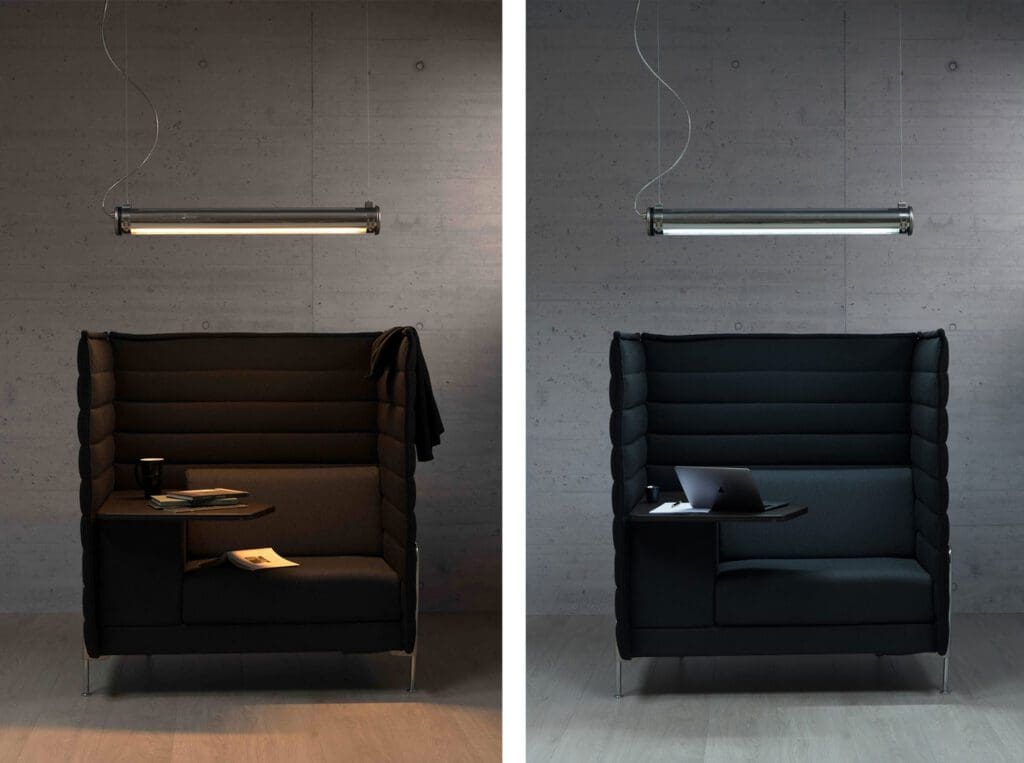The right lighting in the workplace:
Light changes spaces, space changes work
New Work, New Office, New Light
Light plays a decisive, albeit often inconspicuous, role in the lighting of office workplaces and in influencing human well-being. When lighting is inadequate, we often suffer from headaches, lack of concentration and reduced work performance. This is why a successful lighting solution for workplaces, work cafés or relaxation rooms is of great importance and should be able to create a variety of lighting moods by combining different qualities of light.
A meeting room, for example, needs the flexibility to adjust the light according to its purpose, while work areas need to be well lit. A quiet area, on the other hand, should be deliberately subdued.
Office lighting adapts to its use. And to space concepts
New Work, the concept is on everyone’s lips, but what does it really mean?
Open space and shared desk?
Home office and relaxation areas?
Kicker and dogs in the office?
New Work is a state of mind. And space can help bring this state of mind to life in an organization. But each company or organization will have its own needs, and these must be taken into account when planning space. So, for a tech start-up, an open space with flexible zones may make a lot of sense, but for a law firm, it doesn’t make much sense; you need to find other ways.
User-centered lighting in New Work space concepts
And that’s where it all starts. What should be done in the office? Why do employees come to the office? Is it for meetings or projects? Is communication formal or informal?
Once you’ve clearly defined why employees come to the office and what needs to be done there, you can adapt the layout of the premises. And that’s where lighting comes in. It’s not just a question of having enough light on the desk to read your documents. Light can do much more. Good office lighting can help employees to feel good and concentrate, wherever they are.
Lighting for office workstations: how to improve well-being in the workplace?
When it comes to enhancing well-being or concentration, light can make a decisive contribution. Numerous studies have already shown how the intensity and color of light influence our mood, our ability to concentrate and our productivity.
Stimulating lighting
One of the possibilities is Tunable White, an adjustable light source that can offer the light colors present in natural daylight, from 2700K to 6500K. Daylight has different color temperatures throughout the day. In the morning, it’s warm and soft, while around midday it becomes cooler and more intense. This natural evolution of light influences our biorhythm and can help us get into shape in the morning and deliver peak performance at midday.
It’s precisely these natural variations in light that we can imitate in the New Work Office with Tunable White. Starting with warm light in the morning and moving towards cooler light throughout the day, we reflect the natural rhythm of light. Studies show that employees find this type of lighting extremely pleasant and that it boosts productivity.
Our workstation luminaire, the Brueghel, is available with innovative Tunable White technology.

Pleasant light for a feeling of well-being
In order to increase informal communication, spaces such as work cafés often make their appearance in the New Work Office. The ideal mood lighting for these spaces creates a welcoming, comfortable atmosphere that invites employees to feel at ease. This can be achieved, for example, by using indirect light to reflect off walls, ceilings or furniture. Hanging lamps or wall sconces can be used for this purpose. Sammode’s Elgar luminaires are ideal for this type of lighting. Hard shadows are avoided and soft, even lighting is created throughout the room. This creates a feeling of warmth and security. This feeling is further enhanced by the use of warm white light sources with low color temperatures, around 2700 to 3000 Kelvin. Warm light is welcoming and gives the room a charming glow.

Office lighting control improves comfort and reduces energy costs
Lighting control is another important aspect, as it allows a high degree of personalization. The challenge is to determine at an early stage, in close collaboration with the user, what his or her expectations are: How much personalization does the user want, and which aspects simply need to take place in the background?
Different types of light control for office lighting
Different types of lighting control can be used in office lighting to adapt lighting to employees’ needs. However, effective lighting control can not only improve employee comfort and productivity, but also reduce energy costs and contribute to the sustainability of the office building. Here are some of the most common types of lighting control used in office buildings:
- Dimmer switches: dimmer switches allow continuous adjustment of lighting intensity. Employees can increase or decrease light intensity as needed to create a pleasant working environment.
- Presence and motion sensors: these detect the presence of people in the room and automatically switch the light on or off. They are particularly effective in communal areas or corridors, where lighting doesn’t have to be on all the time.
- Daylight control: these systems automatically adapt office lighting to the amount of natural light. They can control blinds or dim artificial light to maintain the desired lighting level.
Good planning for optimum user comfort
It’s important to note, however, that the complexity of control, if not carefully planned, can prevent intuitive, user-friendly use of the room or office.
- For example, the office can be divided into individually controllable zones. In this way, employees can individually adjust the lighting in their own work area.
- Or set up centralized control to manage all office lighting from a central platform. This provides an efficient means of adapting lighting to suit the time of day, work requirements or individual preferences.
- Another option is app-controlled systems, which allow employees to adjust lighting to their own preferences and react to changes in real time.
New Work, New Office, New Light
The New Work movement was launched in the 1980s by Frithjof Bergmann. It is based on the conviction that work can be more than just a paid activity – it must strengthen people and give them deep meaning. Instead of doing a job, people should do what corresponds to their vocation and gives them fulfillment. Over the years, this idea has had a considerable impact on the way we think about work and design our working environments. The New Work is synonymous with a world of work where individual fulfillment and achievement through work are at the center of attention.
The human being at the centre
At the heart of this movement is the human being, the strengthening of the human being through better working methods. And if people feel good, more satisfied and more motivated, for example because their work is meaningful to them, they work better, are more productive, and both benefit: the employees and the company.
To achieve this goal, many factors come into play. These include the search for meaning and self-management, corporate culture and agility, communication and tools, and space. The space has to match what we want to do there, and the lighting has to go with it.
Lighting in the New Work Office
For any office lighting project, you should always ask yourself how bright or dark the room should be, and what light intensity is best for the user. Consideration should also be given to whether uniform or focused lighting is required, and which light colors would be most helpful to users in the room. The decision as to whether to use decorative luminaires as a design element, or functional lighting that is not noticeable, depends on individual needs. The successful combination of these aspects results in first-rate lighting solutions. Contrasts are essential to enhance employee well-being.
Because that’s what it’s all about: creating a calm, pleasant and stimulating environment for employees, according to their needs, in which they can perform their work optimally.

Other interesting articles on the subject of lighting and New Work:
- Room psychology and light: planning and lighting New Work workplaces correctly
- Work Café : Which lighting suits New Work concepts?
- REPLAY – Webinar Light + Space: Planning and illuminating informal meeting rooms


